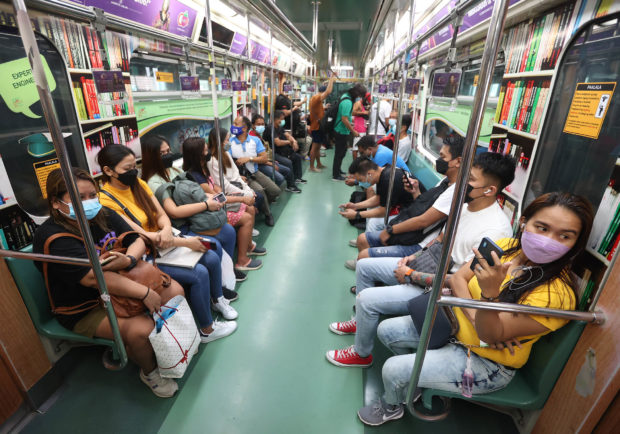COVID-19 infections continue to rise

GETTING THERE | With mass transport systems back to operating at full capacity, the LRT Line 1 in Manila on Tuesday is slowly seeing the return of its “old normal’’ crowd. No more social distancing here, just face masks providing the only protection against coronavirus transmission. (MARIANNE BERMUDEZ / Philippine Daily Inquirer)
MANILA, Philippines — The Department of Health (DOH) on Monday noted the increasing number of people getting sick with COVID-19, reporting 1,682 new cases, or an average of 240 daily infections, last week.
This was 30 percent more than the 185 average daily cases the previous week and was the highest since April 30, although health-care utilization for COVID-19 patients remained at low levels of 20 percent and below.
Authorities confirmed five more people have died of COVID-19, the first multiple deaths in about a month, which brought the death toll to 60,461 out of 3.7 million confirmed cases since the start of the pandemic in 2020.
Still, the DOH said the nationwide alert level 1 remains due to the low rate of hospital admissions and severity of cases.
According to the DOH, 345 of the 2,078 COVID-19 intensive care unit (ICU) beds were occupied, or an increased utilization rate of 16.6 percent from last week’s 14.7 percent. It added that 3,188 of the 15,706 non-ICU beds allocated for COVID-19 patients were in use, or a 20.3-percent utilization rate compared with last week’s 18.1 percent.
The DOH pointed out, however, that the actual number of occupied ICU and non-ICU beds was lower.
It warned, however, that any continuing increase in detected COVID-19 cases might lead to a higher alert level, based on the metrics set by the Inter-Agency Task Force for the Management of Emerging Infectious Diseases (IATF).
“As long as the admissions and severity of cases in the hospitals do not affect our healthcare utilization rate, alert level 1 is still in effect. But we have to be mindful that continuing increases in the cases might lead to an escalation of the alert level,” the DOH said in a statement.
In an interview on Monday, Health Undersecretary Maria Rosario Vergeire said there was always the possibility of escalating to alert level 2 if COVID-19 cases continued to increase.
“What’s important is we are currently not seeing an increase in severe and critical cases and our hospitals are not having problems. We are not observing any increase in admissions” of COVID-19 cases, Vergeire told ABS-CBN Teleradyo.
The DOH urged the public to continue to observe minimum public health standards: wear properly fitted face masks, isolate when sick, get vaccinated and get booster shots when eligible, and ensure good ventilation.
Variants of concern
An adviser to the IATF agreed that the alert level should be raised if the metrics continued to worsen.
“If there is an indication that we have to enhance or increase the alert level to moderate risk, then we should do that. At least, to strengthen our implementation of what is important in mitigating so we won’t reach the critical level,” infectious diseases specialist Rontgene Solante said during Monday’s Laging Handa briefing.
While he did not find Sunday’s 308 new infections — the highest since April 20 — to be “something to worry about,” Solante said this was “not the right time” to lift the state of public health emergency.
“With the threat of these variants of concern, especially these three variants of concern which is globally rising in terms of prevalence, I think this is not the right time yet to lift the public state of health emergency,” Solante said.
President Rodrigo Duterte placed the nation under a state of public health emergency in March 2020 when the COVID-19 threat first emerged in the Philippines.
Solante went on: “If the public state of health emergency will give us leeway to implement the mitigating recommendations and policy so cases will not increase that much, then I would agree that we still [need to] be in a state of public health emergency.”
“The important thing is to really monitor the health-care utilization rate. We need to protect the viability of our healthcare system because once we see that cases are rising and many are getting admitted, then that is something that is not good,” Solante said.
The government will have to strengthen the detection and isolation of COVID-19 cases and make antiviral medicines against COVID-19 “very accessible” to prevent those with comorbidities from getting severe infections and overwhelming hospitals, he added.
RELATED STORIES
DOH posts 386 new COVID-19 cases; active now at 3,097
PH posts 1,682 COVID-19 cases from June 6 to 12 — DOH
Expert retracts, says not yet time to remove ‘emergency’ label on COVID-19 in PH
For more news about the novel coronavirus click here.
What you need to know about Coronavirus.
For more information on COVID-19, call the DOH Hotline: (02) 86517800 local 1149/1150.
The Inquirer Foundation supports our healthcare frontliners and is still accepting cash donations to be deposited at Banco de Oro (BDO) current account #007960018860 or donate through PayMaya using this link.














